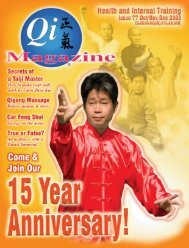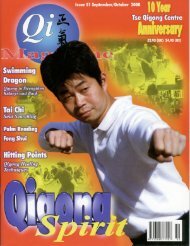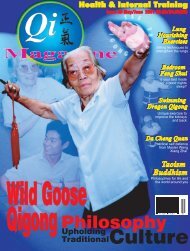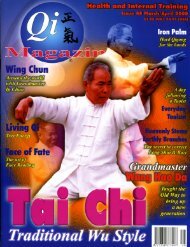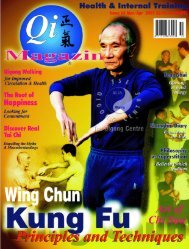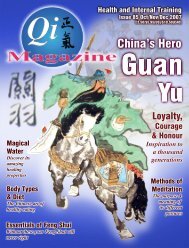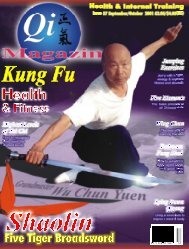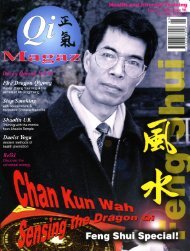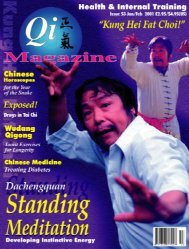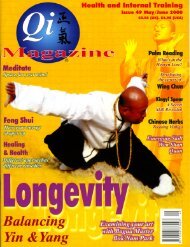Create successful ePaper yourself
Turn your PDF publications into a flip-book with our unique Google optimized e-Paper software.
scanned the page and found that for me this was not the case. It<br />
was an auspicious day for me.<br />
“You need to know what element you are and also what<br />
Chinese animal sign you are. So<br />
for instance if you are a horse,<br />
then the rat is against the horse.<br />
So even though the rat day is a<br />
lucky day, you would need to<br />
choose another day. You cannot<br />
use this day.” There are many,<br />
many things in which a person can<br />
consult an almanac for. For<br />
instance, if a woman is pregnant,<br />
it will advise not to do certain<br />
tasks, like nailing some-thing to<br />
the wall. You can find a day<br />
suitable for a baby’s first hair cut.<br />
As Mr Kwok continued to<br />
explain in more detail, I felt sure<br />
that this was basic stuff but for<br />
someone who knows little about<br />
the Chinese five elements and the<br />
twelve animal signs, then it can be<br />
“Personality”<br />
quite confusing. However, Mr Kwok has made his book quite<br />
simple for Western readers so that if you know your year of<br />
birth, then all you have to do is refer to the footnotes at the<br />
bottom of each day to see if your year comes up. If it does,<br />
despite it being a lucky day, you will know that it is not lucky for<br />
you personally. Having said this, the method is not foolproof. If<br />
you were born very close to the beginning of Chinese spring,<br />
usually 4th or 5th of February, then it may be that your animal<br />
sign year does not correspond to your actual Western year of<br />
birth. You should look at a table or seek advice if not sure as to<br />
when the “Li Chun”, or beginning of spring, is according to the<br />
solar calendar.<br />
Traditionally the almanac was used by farmers who<br />
needed to know<br />
when they<br />
should plant<br />
their fields or<br />
when they<br />
should plan their<br />
harvest. Not<br />
many of the<br />
farmers knew<br />
how to write,<br />
however, they<br />
could read a<br />
m e s s a g e<br />
through a<br />
picture and if<br />
you look in any<br />
Tong Sing today, you will see a picture of a young shepherd with<br />
an ox. If the shepherd is standing with shoes, then it means that<br />
it will be a dry year. If he is wearing shoes, then it means that<br />
there will be lots of rain. There is also a message in where the<br />
boy is standing, before or behind the ox. However, he says that<br />
today this<br />
predictionmethod is<br />
not always correct<br />
as so much of the<br />
nature’s balance has<br />
been destroyed by<br />
industry and such.<br />
I asked Mr<br />
Kwok how he went<br />
about pre-paring an<br />
almanac. It seemed<br />
to me that this task<br />
alone is something<br />
akin to fortune<br />
telling as itis not just<br />
a translation that he<br />
prepares every year,<br />
but he is actually<br />
creating, in English,<br />
a Chinese almanac.<br />
Looking at his notes for his forthcoming almanac for the year<br />
of the Rabbit, I could see it involved a lot of calculations and<br />
much reference to charts relating to the Heavenly Stems and<br />
Earthly Branches, the foundations of Chinese astrology. He<br />
smiled at me and said, “There is only one way to tell how accurate<br />
my book is and that is to compare it to<br />
the Tong Sing when it is published and<br />
he proceeds to do just this.<br />
As we chatted over tea, Mr<br />
Kwok took great care in explaining<br />
several details about the almanac, using<br />
the Chinese terms freely. So often one<br />
finds that you are looked down upon<br />
for being western and wanting to learn<br />
a Chinese skill, so you are given little or<br />
occasionally even incorrect information.<br />
So his sincerity and openness was<br />
greatly appreciated. I did not want to<br />
take too much of his time as he is a busy<br />
person. Once he has finished next year’s<br />
almanac, he has already committed<br />
himself to two further books, one on<br />
the I Ching and one on a prediction<br />
method called, “Holy Cup” which is<br />
common to see in Hong Kong temples.<br />
What began as a hobby in the early 80’s,<br />
Career<br />
assisting a local university in translating<br />
Chinese classics, has now developed into<br />
a career. I hope that the readers of Qi<br />
Magazine will have another opportunity to learn more from Mr<br />
Kwok. Perhaps he will tell us more about the Holy Cup<br />
prediction method.<br />
There is one thing that I know for sure and that is that I<br />
shall consult my almanac for another lucky day in which to plan<br />
for a second interview<br />
byJessicaBlackwell<br />
Photos&CalligraphyfromManHoKowksbook‘ChineseAstrology’,courtesyof<br />
CassellBooks.Tocontact ManHoKwokpleasecontactthe<strong>Tse</strong><strong>Qigong</strong><strong>Centre</strong>.<br />
Qi Magazine 41



